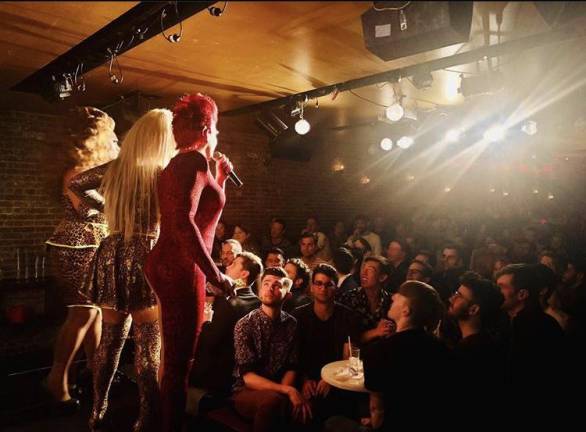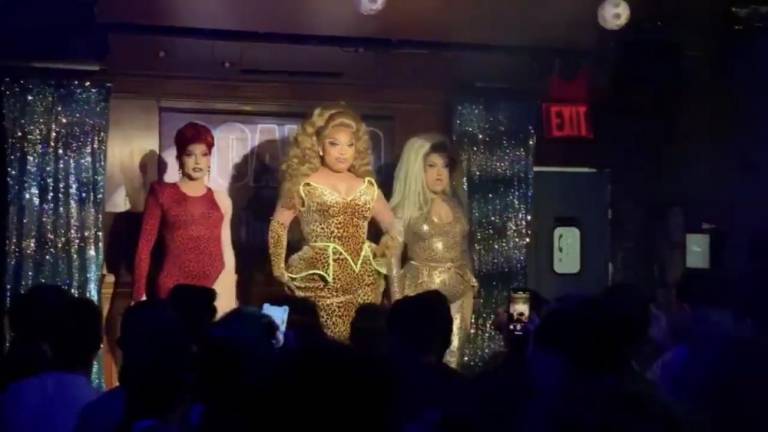Therapy at Therapy
As the Manhattan gay bar announces that it won’t reopen post-COVID, a snapshot of what a good time at the establishment was really like


When I read recently that Manhattan gay bar and lounge Therapy might be unable to recover from the losses caused by the COVID pandemic, it was certainly disheartening. I’d only ever been there twice and seen one performance, but it remains the best drag show I’ve seen in New York City.
The neighborhood of Hell’s Kitchen, a block away from Broadway, is a New York dream that used to be awash in brightly lit signs and posters for musicals like “Mean Girls” and “Beetlejuice.” And in the midst of all this, somewhere in the middle of Eighth and Ninth Avenues on West 52nd Street, was Therapy. My first experience with the bar came on a nippy Thursday night in February at Therapy’s weekly show called “Soaked,” the club’s most packed show of the week, with headlining performers Rosé, Lagoona Bloo, and Brita Filter (although on TV, that’d probably be just Brita).
I remember talking to Ryan Overberg about the show at the time, though I wasn’t able to reach him again in the present. Overberg, Therapy’s 38-year old entertainment director, the man responsible for creating and running these shows, usually stood near the stage to make sure everything went smoothly. Although he’s no stranger to the stage himself. “I was a performer for about 15 years traveling around the country,” he told me. “And then I stopped that to open a bar. I’ve been taking jobs in the meantime that’ll get me there.”
But let’s just say, Overberg taking the stage is not something patrons are going to object to. He’s the kind of guy who’s affable enough to have, oh, maybe 5000 friends on Facebook (but he only has 4996). He’s the kind of guy who’s good enough at what he does to have been on singing cruises and theater productions of “Xanadu,” “Bye Bye Birdie,” and “All Shook Up.” He’s also the kind of guy who’s attractive enough to be the main act on stage at a gay club (where we love to be shallow) with his once-ripped-now-bulky build, his slick hair which has gone from brunette to blonde to brunette, and his 1000-watt smile.
“We’ve just had a history of really excellent performers that have worked here,” Overberg said. “From ‘RuPaul’s Drag Race’, we’ve had Bianca Del Rio, Peppermint, Monét X Change, Bob the Drag Queen. Now we have Jan Sport” (another queen of getting bleeped for copyright), “Brita Filter, and Jackie Cox.” Many of them frequently returned to the mother-bar, and Brita, Jan, and Jackie were part of the new crop of queens that participated on the most recent 12th season of “Drag Race,” the season of the corona.
“Tears in Our Eyes”
Therapy was hardly the first gay bar in New York City to feature drag performers (not when you have institutions like Lucky Cheng’s and Stonewall), but it was certainly one of the most popular. The bar, started and owned by Tom Johnson in 2003, intended to stand out and create a safe space from the get-go. “It’s with tears in our eyes that we have to admit it is highly unlikely that Therapy will ever reopen,” Johnson wrote on the bar’s Facebook page on July 19. The financial losses because of the coronavirus pandemic, coupled with an inability to obtain an extension on the lease, was the death knell for the establishment.
Being right next to Broadway (R.I.P.) was what helped Therapy become a patron of the performing arts. Radio and TV personality Scott Nevins, comedian Randy Rainbow and actress Natalie Joy Johnson have all had runs at the bar. And so did Marti Gould Cummings, a drag queen who hosted a Broadway-themed segment called “Stage Fright” and is now running for New York City Council.
On a “Soaked” night, unless you reserved a table near the stage at the front of the club’s second floor, you would’ve been standing at the back next to the bar (with me, hi). Of the audience, Overberg says, “It is a really strong mix, I would say. A strong mix of ages, of races, of types.” He did add, though, that the vast majority consisted of men who were into other men and possibly more. A few of them in the audience made out with each other, broke out into impromptu lap dances, and one of them at a table nearby slid his hand straight up his partner’s ...
Brita, Rosé, and Lagoona each mentioned part-way through the show that one of the house rules was to tip generously. Drag is a financially intense sport, after all. While outfit prices may vary depending on the performer’s style, a top-notch lace front wig costs hundreds of dollars. Not to mention the makeup, shoes, and jewelry. Several queens have found it especially hard to maintain a steady flow of income during this time, with the source of their tips drying up.
“Soaked” was just one of the numerous drag shows that Therapy once offered. “The Help” was a popular outing that featured queens of color putting on high energy comedy dance routines. There’s “You Tried It! Tuesdays” with Jan, a singing show. And, of course, the Sunday service drag brunch, which might’ve been the closest drag got to religion.
Bars like Therapy form the biggest watering holes for New York drag and are a major part of the city’s nightlife culture. “I think that when people go out and they want their little escape from the world, instead of a jazz singer 60 or 80 years ago, it’s now drag queens,” Overberg said with a smile. “They’re leading us through and entertaining us for a minute to get us away from the bad time in our lives.” If only he knew ...
There’s obviously a tinge of sadness that comes with this nostalgia. Who knows when I, or any of us, will be able to see a live drag show again? Till then, all we can do is support our local performers on their social media and virtual shows. And remember, keep the tips handy!